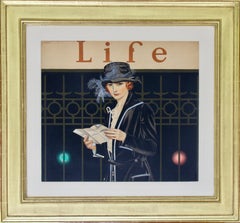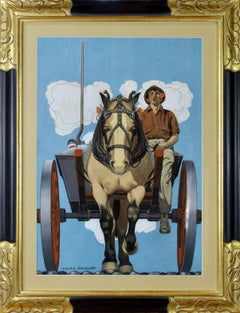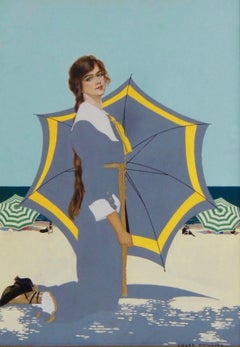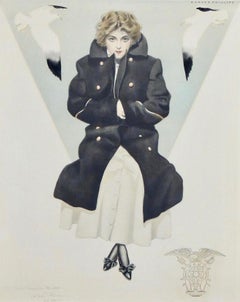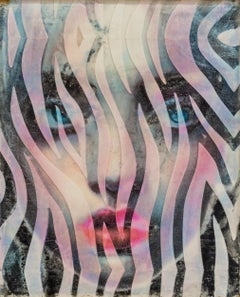Clarence Coles Phillips Art
to
7
6
5
2
1
2
4
Overall Height
to
Overall Width
to
6
4
3
2
2
1
1
1
1
1
1
1
1
1
1
1
1
1
1
1
7
4
3
7
6,910
3,240
2,514
1,217
7
7
4
2
1
Artist: Clarence Coles Phillips
Bag and Baggage, LIFE Magazine cover
By Clarence Coles Phillips
Located in Fort Washington, PA
LIFE Magazine cover, December 15, 1921
"Coles Phillips embodies innovative American periodical and advertising design between 1911 and 1927, a period considered a Golden Age of illu...
Category
1920s Clarence Coles Phillips Art
Materials
Gouache
Collier's Weekly Magazine Cover
By Clarence Coles Phillips
Located in Fort Washington, PA
Signed Lower Left by Artist
Collier's Weekly magazine cover, April 23, 1921
Category
1920s Clarence Coles Phillips Art
Materials
Gouache, Watercolor
Fadeaway Girl, Good Housekeeping Cover
By Clarence Coles Phillips
Located in Fort Washington, PA
Medium: Watercolor
Signature: Signed Lower Right
Sight Size 28.00" x 19.00", Framed 37.00"x 28.00"
Category
1910s Clarence Coles Phillips Art
Materials
Watercolor, Board
USNA Women
By Clarence Coles Phillips
Located in Fort Washington, PA
Signature: Signed Upper Right
Christmas Greetings from the Class of 1912 U S N A
(United States Nava Academy)
"Inscribed: To Ruth Pennington Sutton
C Coles Phillips" Oct 20t...
Category
1910s Clarence Coles Phillips Art
Materials
Watercolor
Community Plate for Oneida Silversmiths Ltd., Advertisement
By Clarence Coles Phillips
Located in Fort Washington, PA
Approximate date: 1924
Medium: Gouache on Board
Signature: Signed Center Left
Sight Size 20.75" x 29.88", Framed 49.00" x 39.00"
Category
1920s Clarence Coles Phillips Art
Materials
Board, Gouache
Good Housekeeping Magazine Cover
By Clarence Coles Phillips
Located in Fort Washington, PA
Cover of Good Housekeeping magazine, January 1915. Image of woman in rocking chair with yarn.
One of the first master illustrators. Created the de...
Category
1910s Other Art Style Clarence Coles Phillips Art
Materials
Watercolor
Hoot Mon, LIFE Magazine Cover
By Clarence Coles Phillips
Located in Fort Washington, PA
Medium: Watercolor and Gouache on Paper
Signature: Signed Lower Left
Sight Size 31.00" x 12.00", Framed 36.00" x 18.00"
Hoot Mon, Life Magazine Cover...
Category
1910s Other Art Style Clarence Coles Phillips Art
Materials
Paper, Gouache, Watercolor
Related Items
INTO THE WILD - Impasto Painting - A.I. Woman in Wooden Frame
By Matthew Dutton
Located in Signal Mountain, TN
Disappearing back into the shadows, she leans into the nature of a new existence, wild and free but still so alone..
In INTO THE WILD, Matthew Dutton creates a new work out of conte...
Category
2010s Contemporary Clarence Coles Phillips Art
Materials
Plaster, Wood, Ink, Watercolor
H 7 in W 9 in D 0.5 in
The Abduction of the Sabine Women , a Renaissance drawing by Biagio Pupini
Located in PARIS, FR
This vigorous drawing has long been attributed to Polidoro da Caravaggio: The Abduction of the Sabine Women is one of the scenes that Polidoro depicted between 1525 and 1527 on the façade of the Milesi Palazzo in Rome. However, the proximity to another drawing inspired by this same façade, kept at the Ecole des Beaux-Arts, and to other drawings inspired by Polidoro kept at the Musée du Louvre, leads us to propose an attribution to Biagio Pupini, a Bolognese artist whose life remains barely known, despite the abundant number of drawings attributed to him.
1. Biagio Pupini, a Bolognese artist in the light of the Roman Renaissance
The early life of Biagio Pupini, an important figure of the first half of the Cinquecento in Bologna - Vasari mentions him several times - is still poorly known. Neither his date of birth (probably around 1490-1495) nor his training are known. He is said to have been a pupil of Francesco Francia (1450 - 1517) and his name appears for the first time in 1511 in a contract with the painter Bagnacavallo (c. 1484 - 1542) for the frescoes of a church in Faenza. He then collaborated with Girolamo da Carpi, at San Michele in Bosco and at the villa of Belriguardo.
He must have gone to Rome for the first time with Bagnacavallo between 1511 and 1519. There he discovered the art of Raphael, with whom he might have worked, and that of Polidoro da Caravaggio. This first visit, and those that followed, were the occasion for an intense study of ancient and modern art, as illustrated by his abundant graphic production.
Polidoro da Caravaggio had a particular influence on the technique adopted by Pupini. Executed on coloured paper, his drawings generally combine pen, brown ink and wash with abundant highlights of white gouache, as in the drawing presented here.
2. The Abduction of the Sabine Women
Our drawing is an adaptation of a fresco painted between 1525 and 1527 by Polidoro da Caravaggio on the façade of the Milesi Palace in Rome. These painted façades were very famous from the moment they were painted and inspired many artists during their stay in Rome. These frescoes are now very deteriorated and difficult to see, as the palace is in a rather narrow street.
The episode of the abduction of the Sabine women (which appears in the centre of the photo above) is a historical theme that goes back to the origins of Rome and is recounted both by Titus Livius (Ab Urbe condita I,13), by Ovid (Fasti III, 199-228) and by Plutarch (II, Romulus 14-19). After killing his twin brother Romus, Romulus populates the city of Rome by opening it up to refugees and brigands and finds himself with an excess of men. Because of their reputation, none of the inhabitants of the neighbouring cities want to give them their daughters in marriage. The Romans then decide to invite their Sabine neighbours to a great feast during which they slaughter the Sabines and kidnap their daughters.
The engraving made by Giovanni Battista Gallestruzzi (1618 - 1677) around 1656-1658 gives us a good understanding of the Polidoro fresco, allowing us to see how Biagio Pupini reworked the scene to extract this dynamic group.
With a remarkable economy of means, Biagio Pupini takes over the left-hand side of the fresco and depicts in a very dense space two main groups, each consisting of a Roman and a Sabine, completed by a group of three soldiers in the background (which seems to differ quite significantly from Polidoro's composition).
The balance of the drawing is based on a very strongly structured composition. The drawing is organised around a median vertical axis, which runs along both the elbow of the kidnapped Sabine on the left and the foot of her captor, and the two main diagonals, reinforced by four secondary diagonals. This diamond-shaped structure creates an extremely dynamic space, in which centripetal movements (the legs of the Sabine on the right, the arm of the soldier on the back at the top right) and centrifugal movements (the arm of the kidnapper on the left and the legs of the Sabine he is carrying away, the arm of the Sabine on the right) oppose each other, giving the drawing the appearance of a whirlpool around a central point of support situated slightly to the left of the navel of the kidnapper on the right.
3. Polidoro da Caravaggio, and the decorations of Roman palaces
Polidoro da Caravaggio was a paradoxical artist who entered Raphael's (1483 - 1520) workshop at a very young age, when he oversaw the Lodges in the Vatican. Most of his Roman work, which was the peak of his career, has disappeared, as he specialised in facade painting, and yet these paintings, which are eminently visible in urban spaces, have influenced generations of artists who copied them abundantly during their visits to Rome.
Polidoro Caldara was born in Caravaggio around 1495-1500 (the birthplace of Michelangelo Merisi, known as Caravaggio, who was born there in 1571), some forty kilometres east of Milan. According to Vasari, he arrived as a mason on the Vatican's construction site and joined Raphael's workshop around 1517 (at the age of eighteen according to Vasari). This integration would have allowed Polidoro to work not only on the frescoes of the Lodges, but also on some of the frescoes of the Chambers, as well as on the flat of Cardinal Bibiena in the Vatican.
After Raphael's death in 1520, Polidoro worked first with Perin del Vaga before joining forces with Maturino of Florence (1490 - 1528), whom he had also known in Raphael's workshop. Together they specialised in the painting of palace façades. They were to produce some forty façades decorated with grisaille paintings imitating antique bas-reliefs.
The Sack of Rome in 1527, during which his friend Maturino was killed, led Polidoro to flee first to Naples (where he had already stayed in 1523), then to Messina. It was while he was preparing his return to the peninsula that he was murdered by one of his assistants, Tonno Calabrese, in 1543.
In his Vite, Vasari celebrated Polidoro as the greatest façade decorator of his time, noting that "there is no flat, palace, garden or villa in Rome that does not contain a work by Polidoro". Polidoro's facade decorations, most of which have disappeared as they were displayed in the open air, constitute the most important lost chapter of Roman art of the Cinquecento. The few surviving drawings of the painter can, however, give an idea of the original appearance of his murals and show that he was an artist of remarkable and highly original genius.
4. The façade of the Milesi Palace
Giovanni Antonio Milesi, who commissioned this palace, located not far from the Tiber, north of Piazza Navona, was a native of the Bergamo area, like Polidoro, with whom he maintained close friendly ties. Executed in the last years before the Sack of Rome, around 1526-1527, the decoration of Palazzo Milesi is considered Polidoro's greatest decorative success.
An engraving by Ernesto Maccari made at the end of the nineteenth century allows us to understand the general balance of this façade, which was still well preserved at the time. The frescoes were not entirely monochrome, but alternated elements in chiaroscuro simulating marble bas-reliefs and those in ochre simulating bronze and gold vases...
Category
16th Century Old Masters Clarence Coles Phillips Art
Materials
Ink, Gouache, Pen
Belisama
By Oswaldo Vigas
Located in Palm Beach, FL
Predominantly recognized as a self-taught painter, he also worked in architectural murals, sculptures, ceramics, prints and drawings.
Vigas is one...
Category
1960s Cubist Clarence Coles Phillips Art
Materials
Canvas, Oil, Gouache, Board
Large Gouache Original Painting Mother & Daughter Sandu Liberman Israeli Judaica
By Sandu Liberman
Located in Surfside, FL
framed 36 X 28 board 30 X 21.75
Sandu Liberman (Romanian-Israeli) was born in Yasi, Romania in 1923. between 1946 and 1953 he took part in the state art shows in Bucharest. in 1952 ...
Category
20th Century Modern Clarence Coles Phillips Art
Materials
Gouache, Paper
Fine Antique French Impressionist Painting View Of A Park with Stone Urn
Located in Cirencester, Gloucestershire
The artist:
Henri Aime Duhem (1860-1941) French *see notes below, signed
Title: The Parkland
Medium:
signed gouache on paper, loosely laid over card, ...
Category
19th Century Impressionist Clarence Coles Phillips Art
Materials
Gouache
Simka Simkhovitch WPA W/C Painting Gouache American Modernist Beach Scene Nude
By Simka Simkhovitch
Located in Surfside, FL
Simka Simkhovitch (Russian/American 1893 - 1949)
This came with a small grouping from the artist's family, some were hand signed some were not.
These were studies for larger paintings.
This is a watercolor and gouache beach scene three young men bathing...
Category
1930s American Modern Clarence Coles Phillips Art
Materials
Watercolor, Gouache, Board
Joan Miro. Original single piece mixed technique painting
By Joan Miró
Located in CORAL GABLES - MIAMI, FL
Joan Miro. Original single piece mixed technique painting
Joan Miro Ferra
1893-1983
Original Study for “EL GOLAFRE ".NOT SIGNED
1979
Unique.
Gouache, lithotint and crayon on paper
...
Category
Late 20th Century Abstract Clarence Coles Phillips Art
Materials
Paper, Ink, Gouache
H 39.77 in W 28.35 in D 0.4 in
Kees Van Dongen Circus Performers 1900s Vintage Vibrant Figure Fauvist Signed
By Kees van Dongen
Located in Milwaukee, WI
"Les Artistes du Cirque" is an original painting in ink, watercolor, and gouache on paper by leading Fauvist artist Kees Van Dongen, signed in the lower right. In the piece, two circus performers stand against against a wall. On the left, a pale woman in a blue leotard with red flowers on the shoulder stands with her arms crossed, looking out at the viewer. The painter fills in her tights with delicate white brushstrokes, lending them an almost iridescent appearance. Her strawberry blond hair is piled on top of her hair according to the fashion of the period. On the right, an African man stands in a vivid orange toga, looking somewhere off to the left. His feet are clad in bright white shoes...
Category
Early 1900s Fauvist Clarence Coles Phillips Art
Materials
Paper, Ink, Watercolor, Gouache
Summer Fashion. Young Victorian Lady With Meadow Flowers In Her Straw Hat
Located in Sutton Poyntz, Dorset
Alice Anne Renshaw.
English ( b.1849 - d.1900 ).
Young Lady With Meadow Flowers In Her Straw Hat
Watercolor & Gouache on Artist's Board ( An embossed stamp in the top left hand corn...
Category
Late 19th Century Realist Clarence Coles Phillips Art
Materials
Watercolor, Gouache, Board
H 29.93 in W 25.6 in D 2.96 in
Richard Caton Woodville II (1856 - 1927) 1794 War Balloon Aquarell England 1910
By Richard Caton Woodville Jr.
Located in Meinisberg, CH
Richard Caton Woodville II
(British, 1856 - 1927)
The French Aerostatic Corps - The first War Balloon The launching of the L'Entreprenant used by the French Army under General Jourd...
Category
1910s English School Clarence Coles Phillips Art
Materials
Paper, Watercolor, Gouache, Cardboard
Free Shipping
H 15.56 in W 22.25 in D 1.58 in
The Star Press - Drawing by Suzanne Tourte - 1950s
Located in Roma, IT
The star press is an artwork realized by Suzanne Tourte, in 1950s.
Original watercolor.
33 x 25 cm.
Good conditions, except for some yellowing on pa...
Category
1950s Modern Clarence Coles Phillips Art
Materials
Paper, Watercolor
Simka Simkhovitch WPA Artist Oil Painting Gouache American Modernist Powerline
By Simka Simkhovitch
Located in Surfside, FL
Simka Simkhovitch (Russian/American 1893 - 1949)
This came with a small grouping from the artist's family, some were hand signed some were not.
These were studies for larger paintings.
Simka Simkhovitch (Симха Файбусович Симхович) (aka Simka Faibusovich Simkhovich) (Novozybkov, Russia May 21, 1885 O.S./June 2, 1885 N.S.—Greenwich, Connecticut February 25, 1949) was a Ukrainian-Russian Jewish artist and immigrant to the United States. He painted theater scenery in his early career and then had several showings in galleries in New York City. Winning Works Progress Administration (WPA) commissions in the 1930s, he completed murals for the post offices in Jackson, Mississippi and Beaufort, North Carolina. His works are in the permanent collections of the Dallas Museum of Art, the National Museum of American Art and the Whitney Museum of American Art. Born outside Kyiv (Petrograd Ukraine) into a Jewish family who owned a small department store. During a severe case of measles when he was seven, Simcha Simchovitch sketched the views outside his window and decided to become an artist, over his father's objections. Beginning in 1905, he studied at the Grekov Odessa Art School and upon completion of his studies in 1911 received a recommendation to be admitted to the Imperial Academy of Arts. Though he enrolled to begin classes in architecture, painting, and sculpture at the Imperial Academy, he was dropped from the school roster in December because of the quota on the number of Jewish students and drafted into the army. Simchovitch served as a private in the 175th Infantry Regiment Baturyn [ru] until his demobilization in 1912. Re-enrolling in the Imperial Academy, he audited classes.
Simka Simkhovitch exhibited paintings and sculptures in 1918 as part of an exhibition of Jewish artists and in 1919 placed 1st in the competition "The Great Russian Revolution" with a painting called "Russian Revolution" which was hung in the State Museum of Revolution. In 1922, Simkha Simkhovitch exhibited at the International Book Fair in Florence (Italian: Fiera Internazionale del Libro di Firenze). In 1924, Simkhovitch came to the United States to make illustrations for Soviet textbooks and decided to immigrate instead. Initially he supported himself by doing commercial art and a few portrait commissions. In 1927, he was hired to paint a screen for a scene in the play "The Command to Love" by Fritz Gottwald and Rudolph Lothar which was playing at the Longacre Theatre on Broadway. Art dealers began clamoring for the screen and Simkhovitch began a career as a screen painter for the theater. Catching the attention of the screenwriter, Ernest Pascal, he worked as an illustrator for Pascal, who then introduced him to gallery owner, Marie Sterner. Simkhovitch's works appeared at the Marie Sterner Gallery beginning with a 1927 exhibit and were repeated the following year. Simkhovitch had an exhibit in 1929 at Sterner's on circus paintings. In 1931, he held a showing of works at the Helen Hackett Gallery, in New York City and later that same year he was one of the featured artists of a special exhibit in San Francisco at the California Palace of the Legion of Honor in Lincoln Park. The exhibit was coordinated by Marie Sterner and included four watercolors, including one titled "Nudes". He is of the generation of Russian Soviet artists such as Isaac Pailes, Serge Charchoune, Marc Chagall, Chana Orloff, Isaac Ilyich Levitan, and Ossip Zadkine.
In 1936, Simkhovitch was selected to complete the mural for the WPA Post office project in Jackson, Mississippi. The mural was hung in the post office and courthouse in 1938 depicted a plantation theme. Painted on the wall behind the judge’s bench, “Pursuits of Life in Mississippi”, a depiction of black workers engaged in manual labor amid scenes of white professionals and socialites, was eventually covered over in later years during renovations due to its stereotypical African American imagery. Simka painted what he thought was typical of Jackson. His impression of pre-civil rights Mississippi was evidently Greek Revival column houses, weeping willow trees, working class families, and the oppression of African Americans. He painted African American men picking cotton, while a white man took account of the harvest and a white judge advised a white family, calling it Pursuits of Life in Mississippi.
Though clearly endorsed by the government and initially generally well-received, the mural soon raised concerns with locals as the climate toward racial segregation began to change. The main concern was whether depictions that show African Americans in subjugated societal roles should be featured in a courtroom. The following year, his painting "Holiday" won praise at an exhibition in Lincoln, Nebraska. In 1940, Simkhovitch's second WPA post office project was completed when four murals, "The Cape Lookout Lighthouse and the Orville W. Mail Boat", "The Wreck of the Crissie Wright", "Sand Ponies" and "Canada Geese" were installed in Beaufort, North Carolina. The works were commissioned in 1938 and did not generate the controversy that the Jackson mural had. The main mural is "The Wreck of the Crissie Wright" and depicts a shipwreck which had occurred in Beaufort in 1866. "The Cape Lookout Lighthouse and the Orville W. Mail Boat" depicted the lighthouse built in 1859 and the mail boat that was running mail during the time which Simkhovitch was there. The boat ran mail for the area until 1957. "Sand Ponies" shows the wild horses common to the North Carolina barrier islands and "Canada Geese" showed the importance of hunting and fishing in the area. All four murals were restored in the 1990s by Elisabeth Speight, daughter of two other WPA muralists, Francis Speight...
Category
1930s American Modern Clarence Coles Phillips Art
Materials
Gouache, Oil, Board
Clarence Coles Phillips art for sale on 1stDibs.
Find a wide variety of authentic Clarence Coles Phillips art available for sale on 1stDibs. You can also browse by medium to find art by Clarence Coles Phillips in paint, watercolor, gouache and more. Not every interior allows for large Clarence Coles Phillips art, so small editions measuring 12 inches across are available. Customers who are interested in this artist might also find the work of Arthur Beecher Carles, Francis Luis Mora, and Robert Spencer. Clarence Coles Phillips art prices can differ depending upon medium, time period and other attributes. On 1stDibs, the price for these items starts at $29,500 and tops out at $125,000, while the average work can sell for $69,000.
